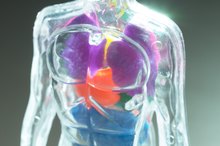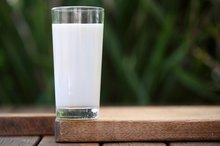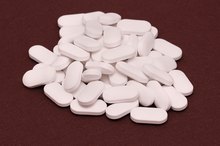What Causes Calcium Deposits and Calcification?
Calcium is a vital mineral to help support your body’s metabolic functions, especially bone and muscle health. Sometimes, calcium buildup can occur in other places, so you’ll want to be aware of the root causes of calcium deposits to understand when you might need to take action.
Tips
Calcium deposits in the body often form as a result of physical stress and tissue damage, but most of the time, they aren't cause for serious concern.
Calcium in the Body
You’ve probably heard that calcium grows strong bones to keep you healthy as you age. But what else does it do for your body? According to the National Osteoporosis Foundation, calcium builds your bones and muscles and enables blood to clot 12.
About 99 percent of the calcium found in your body is in the bones and teeth.
The body does not produce calcium on its own. Instead, it’s found in foods like yogurt, milk, salmon and even kale — and it can also be consumed as a dietary supplement.
The amount you need per day depends on your age, as well as your biological sex, and can range anywhere from 200 milligrams for babies to 1,000 milligrams for breastfeeding adults. The National Institutes of Health warns that vegans, people with lactose sensitivities, postmenopausal women, and people with amenorrhea often need higher levels of calcium than others 2.
Read more: Do You Have a Calcium Deficiency? Here's How to Tell
- You’ve probably heard that calcium grows strong bones to keep you healthy as you age.
- About 99 percent of the calcium found in your body is in the bones and teeth.
What Causes Calcium Deposits?
Calcium's Effects on the Nervous System
Learn More
Due to a variety of factors, calcium deposits can build up in regions of the body outside the bones and teeth.
One of the most common reasons is tissue damage — when an area of tissue is damaged due to injury or inflammation, the body responds by sending calcium to help harden and heal the area 3. This can happen in the joints or muscles and is often so small that it can only be spotted by a radiologist.
In many cases, calcification is a harmless and perfectly natural biological response to physical stress. Small calcifications in body tissue and joints typically need not be removed unless they are causing physical pain or limited movement.
- Due to a variety of factors, calcium deposits can build up in regions of the body outside the bones and teeth.
Calcium in the Breast
One common place for calcium buildup is the breast. Harvard Health estimates that 50 percent of women over 50 and 10 percent of younger women have calcifications in their breast tissue, which typically shows up on a mammogram 24. The majority of the time, it stems from prior injury or benign growths and is nothing to worry about 13.
But can calcium deposits ever turn into cancer?
The calcium itself does not cause cancer, but it could be a signal of something happening in the breast tissue — and in rare cases, it can reveal early stage cancer 5. Your radiologist can examine the calcifications and determine whether or not they are linked to a deeper problem.
Read more: 5 Things You Need to Know About Breast Cancer Symptoms
- One common place for calcium buildup is the breast.
- Your radiologist can examine the calcifications and determine whether or not they are linked to a deeper problem.
Symptoms of Calcium Deposits
Can Too Much Calcium Carbonate Have Side Effects?
Learn More
If the calcium deposits are small, it may take years for you to develop adverse symptoms (or you may never have symptoms at all). If you begin to notice any pain or pinching feelings, it could mean the calcium deposit is becoming inflamed, in which case it’s important to talk to your doctor 6.
Occasionally, calcifications left untreated can harden over time and put pressure on the existing muscles and tendons. This is called calcific tendonitis, and it often shows up in the rotator cuff in the shoulder 7. Luckily, the vast majority of cases can be treated without surgery, using methods like medication or shock-wave therapy.
The body will likely reabsorb the calcium deposit on its own after a period of several months, but this process can be painful if you don’t work to counteract it with treatment. In rare cases, surgery may be the only option to remove the calcification and allow the joints to function normally.
- If the calcium deposits are small, it may take years for you to develop adverse symptoms (or you may never have symptoms at all).
- Occasionally, calcifications left untreated can harden over time and put pressure on the existing muscles and tendons.
Calcium Intake and Calcifications
It might seem logical to cut down on your calcium intake to reduce calcium deposits in the body — but according to Harvard Health, no direct link has been identified between calcium intake and soft tissue accumulation 4. In other words, the calcium you eat has no proven correlation with the calcium buildup in your body.
Some studies have shown a connection between calcium supplement intake and heart disease in older adults, so if this is something you’re concerned about, it may be worth discussing with your doctor 10. Harvard Health says that while the link between calcium supplements and heart health is unclear, it’s typically best to derive your calcium intake from food rather than pills — unless your doctor explicitly tells you otherwise 410.
Read more: Is It Safe to Take Vitamin C and Calcium Together?
- It might seem logical to cut down on your calcium intake to reduce calcium deposits in the body — but according to Harvard Health.
Calcium in the Blood
Overall, calcium buildup in the body isn’t cause for immediate concern, but sometimes it may not be so innocuous. If calcium begins hardening in the arteries, as it often does in individuals over 60 years of age, it can put pressure on the heart and lead to heart failure. A coronary calcium scan can detect the presence of calcium in the arteries, which can help with heart disease prevention 212.
In rare cases, calcification can occur in the brain in what is called primary familial brain calcification disorder 13.
This is a neurodegenerative disease that shows up in individuals in the middle of life, and can cause symptoms such as loss of motor development and slurred speech. It differs in every individual, according to the National Organization for Rare Disorders, and some people may go decades without noticing any symptoms 13.
A February 2018 study in the journal Nature discovered a potential link between calcium and Parkinson’s disease, but this research is still in early stages.
Again, this is something to discuss with your doctor if you are concerned about a possible connection between calcium and your health. Each situation is different, and only an individual analysis can determine whether it’s something that requires further attention.
Ultimately, your health care provider can help you determine whether calcification in the body poses a health risk. If the buildup is benign, as it often is, it can stay in your body for years without requiring medical action — but if it’s causing you problems, it should be addressed with treatment in mind.
- Overall, calcium buildup in the body isn’t cause for immediate concern, but sometimes it may not be so innocuous.
Related Articles
References
- National Osteoporosis Foundation: "Calcium/Vitamin D"
- National Institute of Health: "Calcium"
- University of Washington Department of Radiology: "Soft Tissue Calcifications" "
- Harvard Health Publishing: "Calcium Beyond the Bones"
- BreastCancer.org: "Understanding Breast Calcifications"
- Southern California Orthopedic Institute: "Calcium Deposits in the Shoulder"
- Joints: "Calcific Tendinitis of the Shoulder"
- Journal of Clinical & Diagnostic Research: "Calcific Tendinitis of the Rotator Cuff: A Review"
- Journal of the American Heart Association: "Calcium Intake From Diet and Supplements and the Risk of Coronary Artery Calcification and its Progression Among Older Adults: 10‐Year Follow‐up of the Multi‐Ethnic Study of Atherosclerosis (MESA)"
- Harvard Health Publishing: "Calcium and Heart Disease: What Is The Connection?"
- AHA Journals: "Vascular Calcification"
- National Heart, Lung, and Blood Institute: "Coronary Calcium Scan"
- National Organization for Rare Disorders: "Primary Familial Brain Calcification"
- Nature: "C-Terminal Calcium Binding of α-Synuclein Modulates Synaptic Vesicle Interaction"
- Bolland, MJ, et. al. Calcium supplements with or without vitamin D and risk of cardiovascular events: reanalysis of the Women's Health Initiative limited access dataset and meta-analysis. BMJ. 2011 Apr 19;342:d2040. DOI: 10.1136/bmj.d2040
- Reid IR. The roles of calcium and vitamin D in the prevention of osteoporosis. Endocrinol Metab Clin North Am. 27: 389-398. DOI:10.1016/s0889-8529(05)70011-6
- Chen M, Pan A, Malik VS, Hu FB. Effects of dairy intake on body weight and fat: a meta-analysis of randomized controlled trials. The American Journal of Clinical Nutrition. 2012;96(4):735-747. DOI:10.3945/ajcn.112.037119
- Williams V, Rawat A, Vignesh P, Shandilya JK, Gupta A, Singh S. Fc-gamma receptor expression profile in a North-Indian cohort of pediatric-onset systemic lupus erythematosus: An observational study. Int J Rheum Dis. 2019;22(3):449-457. doi: 10.6061/clinics/2012(07)22
- Reid IR, Birstow SM, Bolland MJ. Calcium and Cardiovascular Disease. Endocrinol Metab (Seoul). 2017;32(3):339-349. doi: 10.3803/EnM.2017.32.3.339
- MedlinePlus Medical Encyclopedia, "Milk-alkali syndrome"
- Bolland MJ, Grey A, Avenell A, Gamble GD, Reid IR. Calcium supplements with or without vitamin D and risk of cardiovascular events: reanalysis of the Women’s Health Initiative limited access dataset and meta-analysis. BMJ. d2040-d2040. DOI:10.1136/bmj.d2040
- Chan Soo Shin, et. al. Endocrinol Metab (Seoul). 30(1): 27–34. DOI: 10.3803/EnM.2015.30.1.27
- Linus Pauling Institute. Calcium.
- National Institute of Health Office of Dietary Supplements. Calcium.
- Weingarten MAMA, Zalmanovici Trestioreanu A, Yaphe J. Dietary calcium supplementation for preventing colorectal cancer and adenomatous polyps. Cochrane Database of Systematic Reviews 2008, Issue 1. Art. No.: CD003548. DOI: 10.1002/14651858.CD003548.pub4
- Zemel, MB et. al. Calcium and dairy acceleration of weight and fat loss during energy restriction in obese adults. Obes Res. 2004 Apr;12(4):582-90. DOI: 10.1038/oby.2004.67









